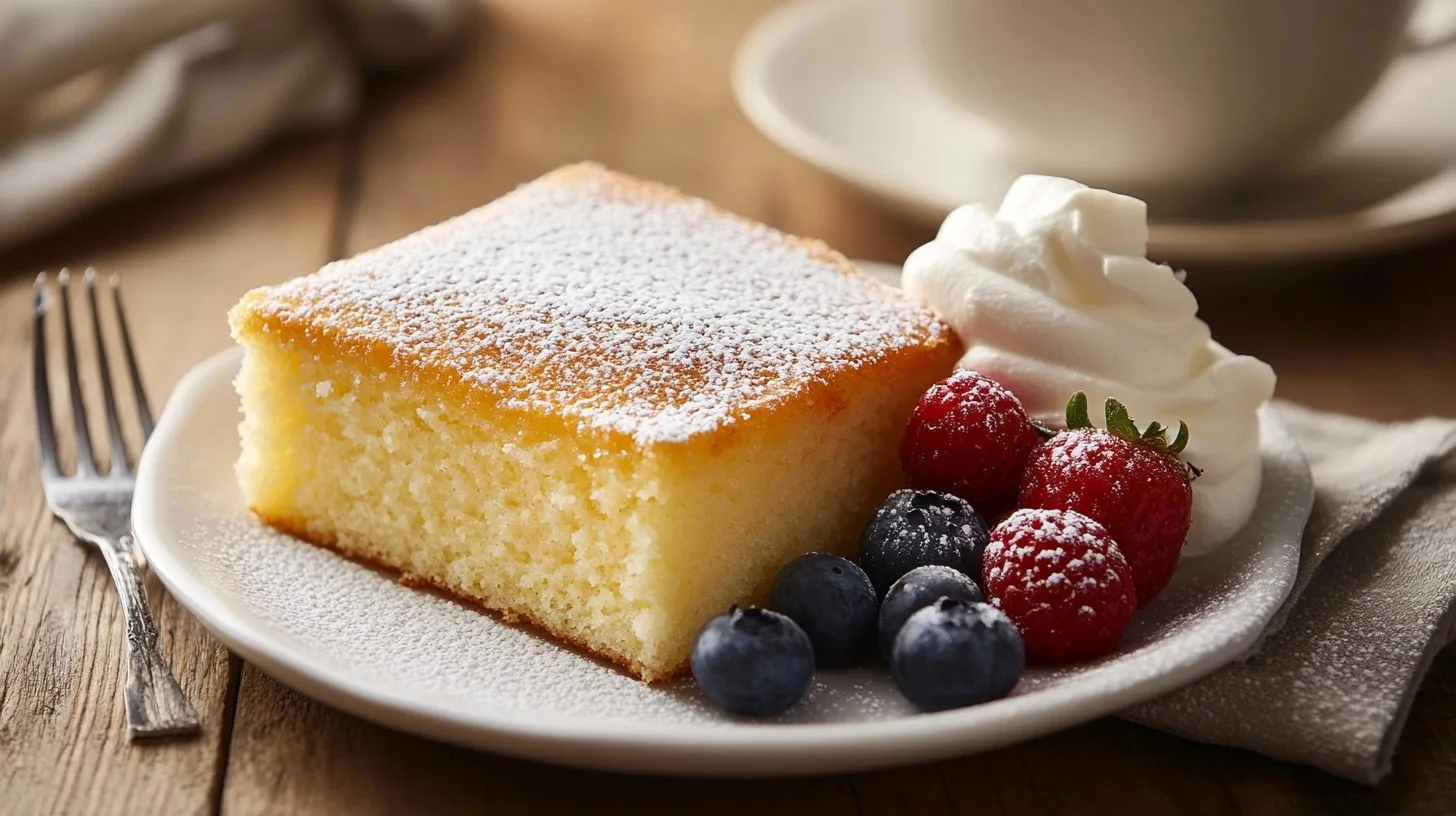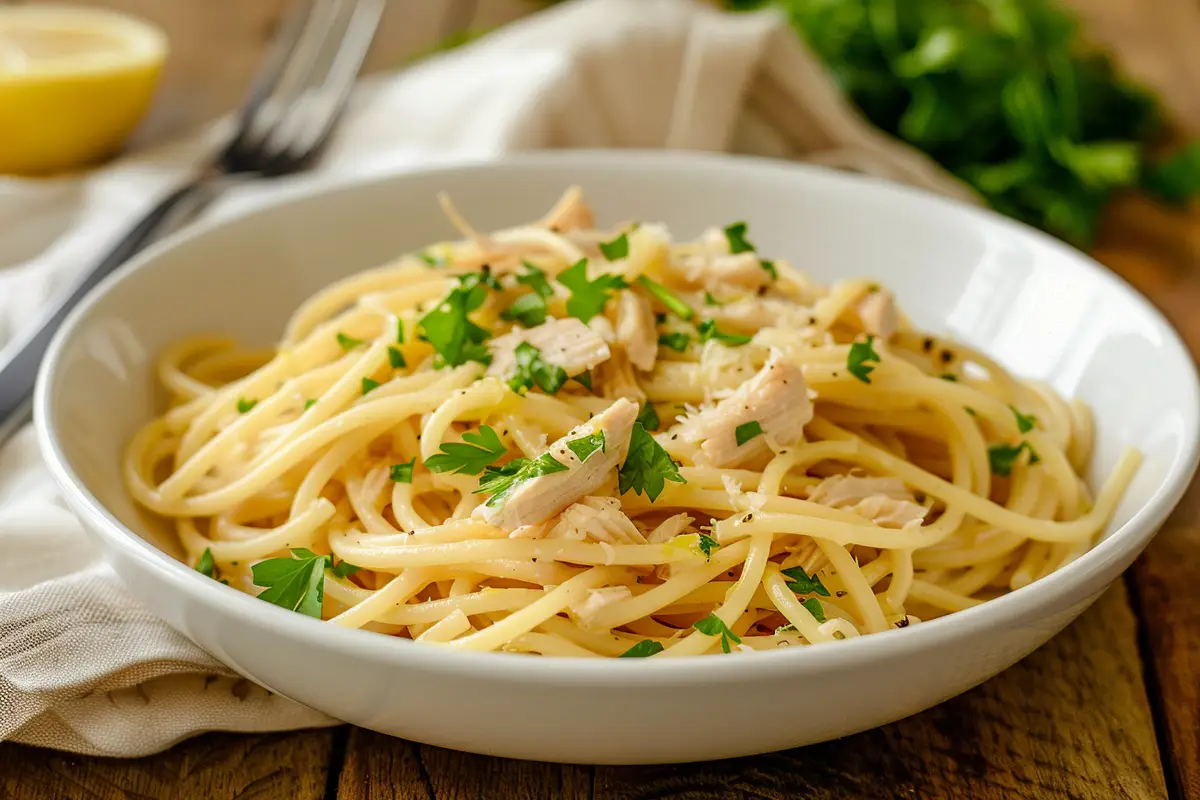Kefir sheet cake is the perfect fusion of simplicity and indulgence. With its unique tangy flavor and moist crumb, this delightful dessert is a must-try for any baking enthusiast. Whether you’re exploring the versatility of fermented milk or searching for a new go-to recipe, this article offers everything you need. From a step-by-step guide to tips on how to enhance the flavor and create a fluffy cake, you’ll leave inspired and ready to start baking.
Table des matières
What is Kefir and Why Use It in Baking?
Kefir is a fermented milk product packed with probiotics. Its rich probiotic content enhances gut health while adding a tangy flavor that sets desserts apart. When used in baking, fermented milk plays a crucial role in creating a moist and fluffy crumb.
Why does kefir help in baking?
- Its acidity activates baking soda and baking powder, ensuring the batter rises properly.
- Kefir’s probiotic and fermented milk properties create a tender texture.
For more on how automated systems like KEFIR can enhance healthcare data analysis, explore this research paper by GTE Laboratories, which highlights KEFIR’s application in detecting key findings and providing actionable recommendations.
What Makes Kefir Sheet Cake Special?
A kefir sheet cake combines the ease of a sheet cake with the tangy flavor of fermented milk, making it a dessert that’s sure to impress. The tanginess of the kefir balances the sweetness, giving it a more complex flavor profile.
Here’s what sets it apart:
- fermented milk helps keep the cake moist.
- The light and fluffy texture comes from the balance of wet ingredients and dry ingredients.
- It’s a versatile dessert, perfect for plain or topped with a cream cheese frosting.
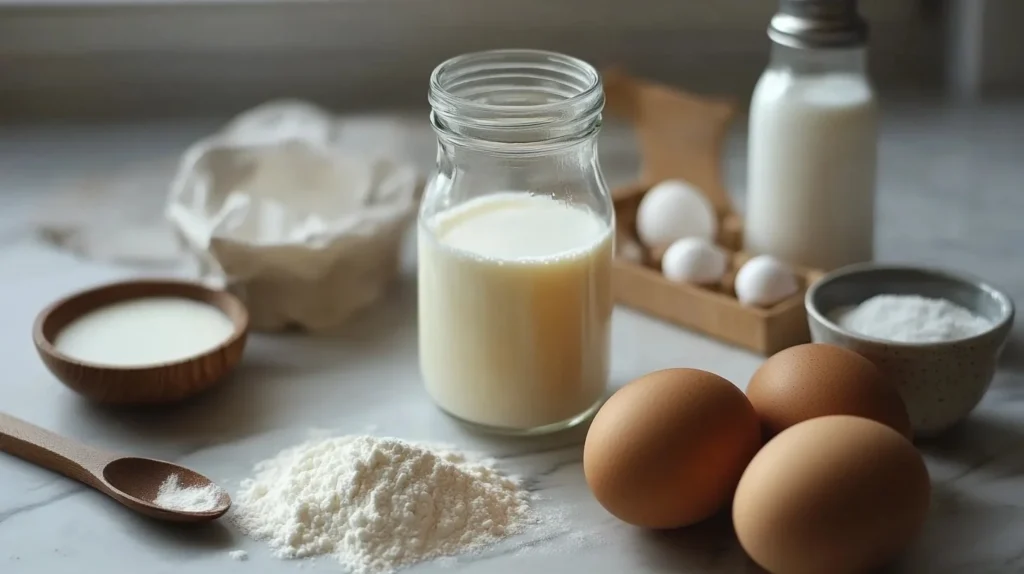
Key Ingredients for a Perfect Kefir Cake
To create the perfect fermented milk sheet cake recipe, you’ll need these essentials:
- Kefir: The star ingredient that ensures a moist crumb and enhances the tangy flavor.
- Baking soda and baking powder: Crucial for leavening the batter.
- Vanilla extract: Adds depth to the flavor.
- Vegetable oil: Helps to keep the cake moist without overpowering the flavor.
- Dry ingredients (flour, sugar, salt): Ensure structure and sweetness.
Step-by-Step Guide to Preparing Kefir Sheet Cake
Step1: Prepare the Baking Pan
- Preheat your oven to 350°F.
- Line the baking pan with parchment paper for easy removal.
Step2: Mix the Dry Ingredients
- Combine flour, sugar, baking powder, and salt in a bowl. Stir until the dry ingredients are evenly distributed.
Step3: Combine Wet Ingredients
- In a separate bowl, whisk cultured milk, eggs, vanilla extract, and vegetable oil.
- Gradually add the dry ingredients to the wet to form a smooth batter. Be careful not to overmix.
Step4: Pour and Bake
- Pour the batter into the prepared sheet pan and spread it evenly.
- Bake for 25–30 minutes or until a toothpick inserted into the center comes out clean.
Step5: Cool and Serve
- Let the cake cool in the pan for 10 minutes, then transfer to a wire rack to cool completely.
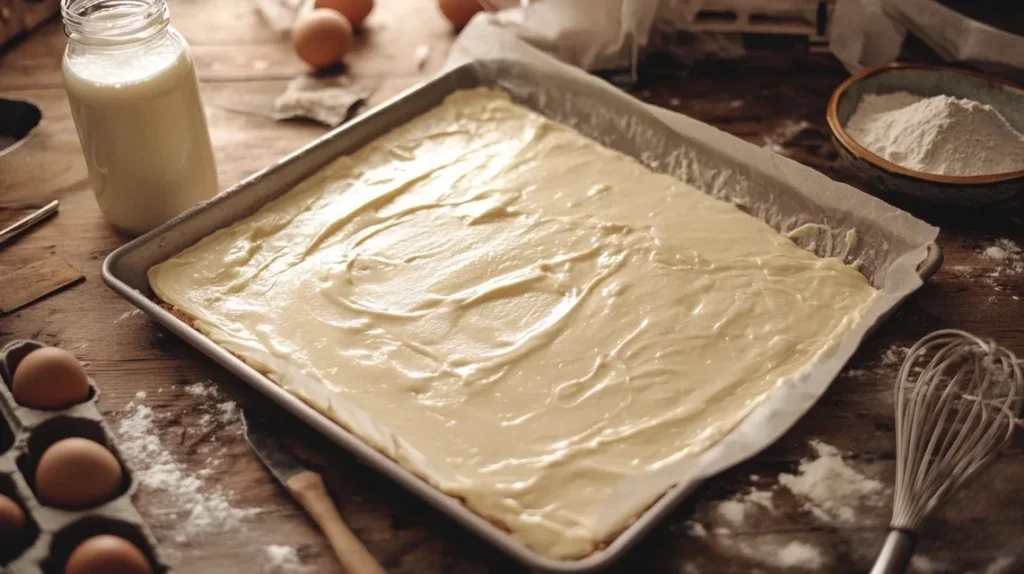
Common Mistakes and How to Avoid Them
- Overmixing the Batter:
- Overmixing can lead to a dense texture. Stir until everything is combined but stop before the gluten overdevelops.
- Incorrect Measurements:
- Baking is a science. Use precise measurements for wet ingredients and dry ingredients.
- Not Preheating the Oven:
- Always preheat your oven to 350°F for consistent results.
How to Keep Your Cake Moist and Fluffy
The secret to a moist and fluffy cake lies in the balance of ingredients:
- Use kefir to keep the cake moist and add a tangy flavor.
- Incorporate vegetable oil instead of butter for added moisture.
- Avoid overbaking, as this can dry out the cake.
Tips for Adding Berries or Other Flavors
Adding berries like blueberries or raspberries can elevate the fermented milk sheet cake recipe. Here’s how:
- Toss berries in a little flour before folding them into the batter. This prevents them from sinking.
- For added sweetness, sprinkle a layer of sugar on the berries before baking.
For a fruity twist, you can explore pairing your kefir sheet cake with complementary berry treats like this Blueberry Dump Cake.
Storing and Serving Suggestions
Once the cake has cooled, store it properly to maintain freshness:
- Wrap tightly in plastic wrap or place in an airtight container in the fridge.
- Serve plain or top with a tangy cream cheese frosting.
Pro Tip: Let the cake cool completely before storing it to avoid trapping moisture.
Why Kefir is a Star Ingredient in Desserts
Kefir provides a unique combination of flavor and texture:
- Its probiotic properties make desserts healthier.
- The tanginess of the cultured milk complements sweet desserts perfectly.
Experimenting with Variations and Gluten-Free Options
Experiment with different flours or add-ins to customize your cake:
- Substitute regular flour with a gluten-free flour blend for a celiac-friendly dessert.
- Add chocolate chips or nuts for added texture and flavor.
For a hearty and gluten-free alternative, check out this Best Oat Molasses Bread Recipe. Or for a richer dessert variation, try topping your cake with ideas inspired by these Toffee Squares with Caramel.
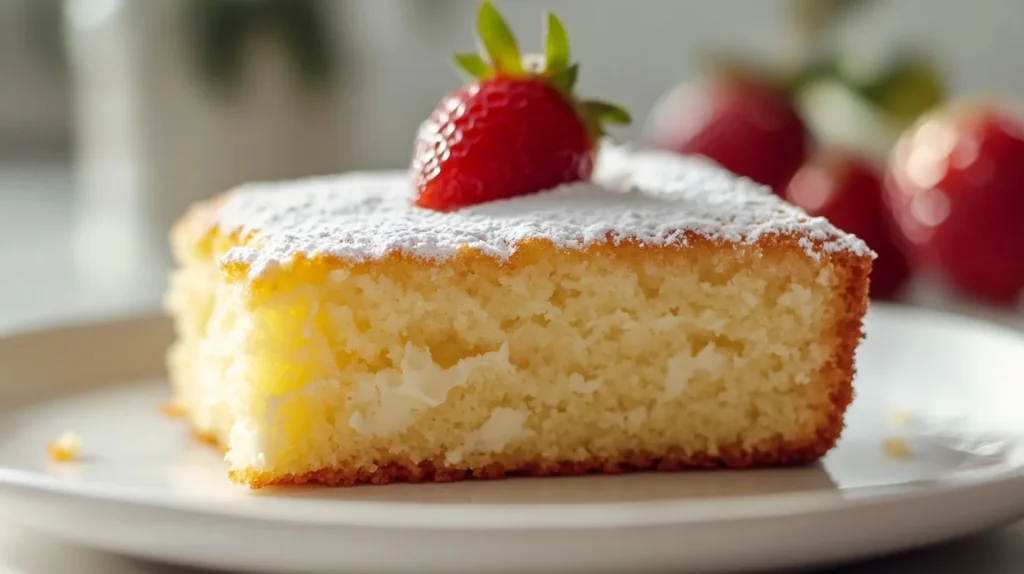
How to Make This Cake: Baking Time and Tips
If you’re ready to make this cake, it’s essential to understand the proper baking time and techniques to achieve a flawless result. Follow these tips to ensure your kefir sheet cake turns out perfectly every time.
Step-by-Step Baking Guide
- Preheat Your Oven
- Before starting, preheat your oven to 350°F. Proper preheating ensures even baking and helps the batter rise effectively.
- Prepare the Pan
- Line your baking pan with parchment paper. This prevents sticking and makes it easier to remove the cake after baking.
- Pour the Batter
- After mixing your batter (be sure not to overmix), pour the batter into the prepared sheet pan and spread it evenly using a spatula.
- Set the Timer
- The ideal baking time is 25–30 minutes. Check for doneness by inserting a toothpick into the center. If the toothpick comes out clean, the cake is fully baked.
- Cool Before Serving
- Let the cake cool in the pan for 10 minutes, then transfer to a wire rack to cool completely.
Pro Tips for Success
- Ensure all wet ingredients are at room temperature before mixing. This helps the batter combine smoothly.
- Keep an eye on the oven during the last few minutes of baking time to avoid overbaking.
With these tips, you’re ready to create the ultimate kefir sheet cake that’s sure to impress!
Detailed Tips for Baking and Creating Your Next Cake
If you’re considering making a cake with a difference, a fermented milk sheet cake is an excellent choice. Not only does it have a full flavor profile, but it’s also easy to make and versatile enough to become your perfect cake for any occasion.
Preparing the Baking Sheet
Before you create a cake, it’s crucial to prepare your tools correctly:
- Use a baking sheet or baking pan that’s sturdy and non-stick.
- Line it with parchment paper to ensure easy release once the cake is baked.
Mixing the Batter
- Start by combining the wet ingredients and dry ingredients in separate bowls.
- Add the kefir to the wet mixture to bring in the tangy flavor.
- Incorporate vanilla extract into the batter and add the eggs one at a time to ensure a smooth consistency.
- Mix everything using an electric mixer for a lump-free, light batter. Avoid overmixing for the best texture.
Baking Your Kefir Sheet Cake
- Preheat your oven to 350°F. Proper preheating is essential for even cooking.
- Spread the batter into the prepared sheet pan, ensuring it’s even. This ensures a consistent bake.
- Place the pan in the oven and bake for 25–30 minutes. The center may be slightly springy when pressed, but a toothpick inserted into the center should come out clean.
Storing and Serving
After baking, allow the cake to cool completely. To store the cake:
- Wrap it tightly in plastic wrap, or store it in an airtight fridge container.
- A topping of cream cheese frosting pairs beautifully with the tangy flavor of the cultured milk cake.
Planning Your Next Cake
Once you’ve mastered this recipe, you’ll likely wonder why fermented milk hasn’t been your go-to ingredient for desserts before! Its versatility allows you to experiment with variations. Whether you’re baking a berry-filled treat or trying chocolate-based options, kefir can make each one stand out.
Ready to create a cake that’s not only full of flavor but also unforgettable? This recipe is a foundation you’ll turn to again for your next cake.
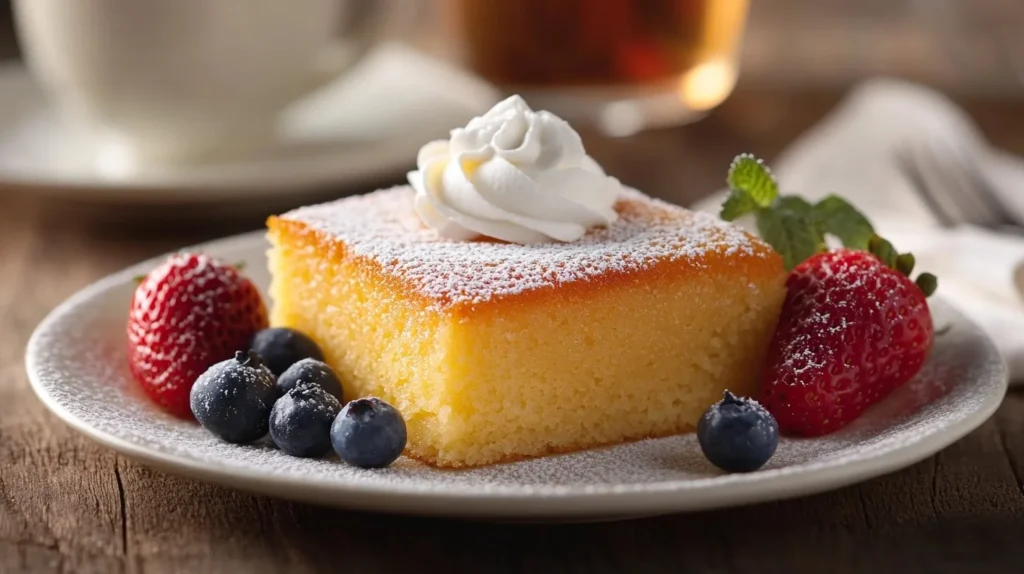
FAQs About Kefir in Baking
1. What does kefir do in baking?
cultured milk enhances baked goods by adding a tangy flavor, keeping them moist, and improving texture. Its acidity activates baking soda, helping the batter rise for a fluffy crumb.
2. Can I use kefir instead of buttermilk in a cake?
Yes, cultured milk is an excellent substitute for buttermilk. It mimics the tangy acidity and moisture of buttermilk, making it ideal for cakes, biscuits, and pancakes.
3. Can I use kefir instead of milk in baking?
Absolutely! Kefir can replace milk in most recipes, offering a thicker consistency and an added probiotic boost for better flavor and texture.
4. How do you keep a sheet cake moist?
To keep a sheet cake moist:
- Use ingredients like cultured milk and vegetable oil.
- Avoid overbaking, and wrap the cake tightly or store it in an airtight container to preserve freshness.
5. Does kefir lose its probiotics when heated?
Yes, high heat (above 115°F) destroys kefir’s probiotics. Use it in recipes where it’s added after cooling or consumed unheated for maximum health benefits.
6. Why can I drink kefir but not milk?
cultured milk is easier to digest because its probiotic bacteria break down lactose, making it suitable for those with lactose intolerance. It’s a great alternative to milk for people with sensitive stomachs.
Conclusion
Baking with kefir opens up a world of possibilities, offering a simple yet transformative way to elevate your desserts. Its tangy flavor and ability to keep baked goods moist and fluffy make it a star ingredient for anyone looking to create something truly special. Whether you’re experimenting with a kefir sheet cake recipe, substituting it for buttermilk or milk, or exploring its health benefits, cultured milk is a versatile and nutrient-rich addition to your kitchen.
Remember to:
- Use kefir to enhance texture and flavor.
- Avoid overmixing the batter for the best results.
- Store your cake properly to maintain freshness.
By following these tips and techniques, you can create a cake that’s not only full of flavor but also a standout dessert for any occasion. Ready to start baking your next masterpiece? Try kefir and see why it’s becoming a favorite in kitchens everywhere.
Want to see more? If you enjoyed this article, we invite you to join us on our Facebook page ElyseRecipes. That way, you’ll be among the first to hear about our updates, cooking tips, and recipe ideas! Come share your passion and connect with our community.

